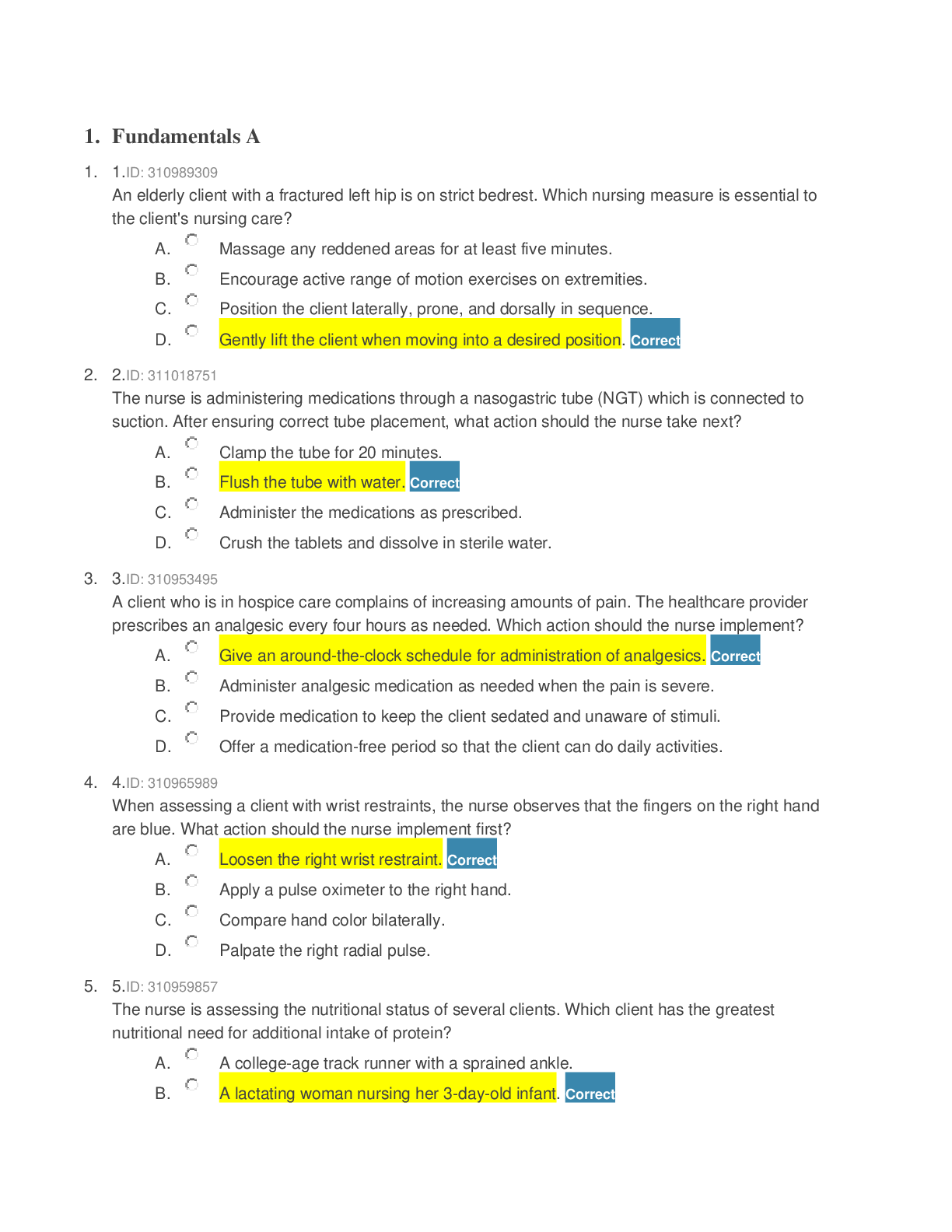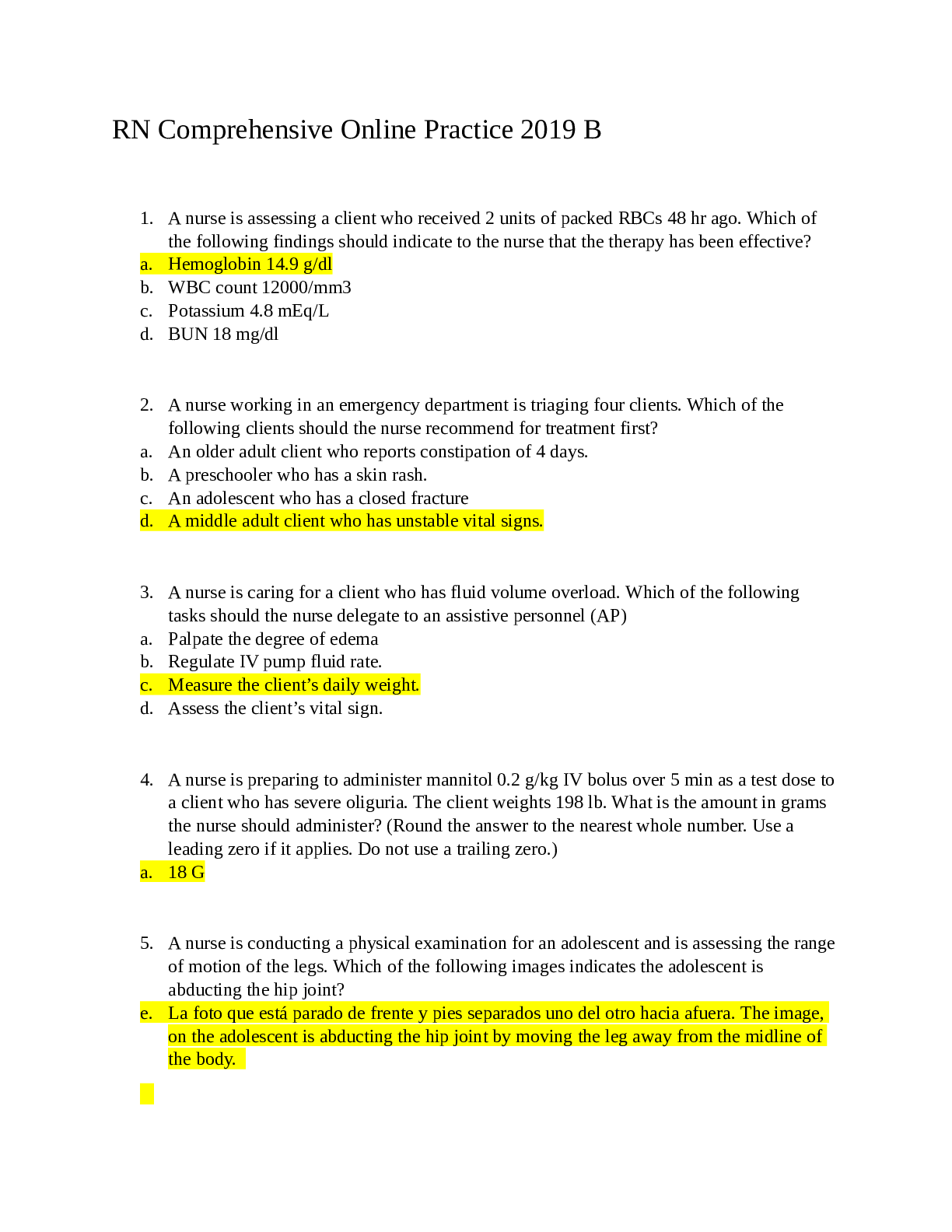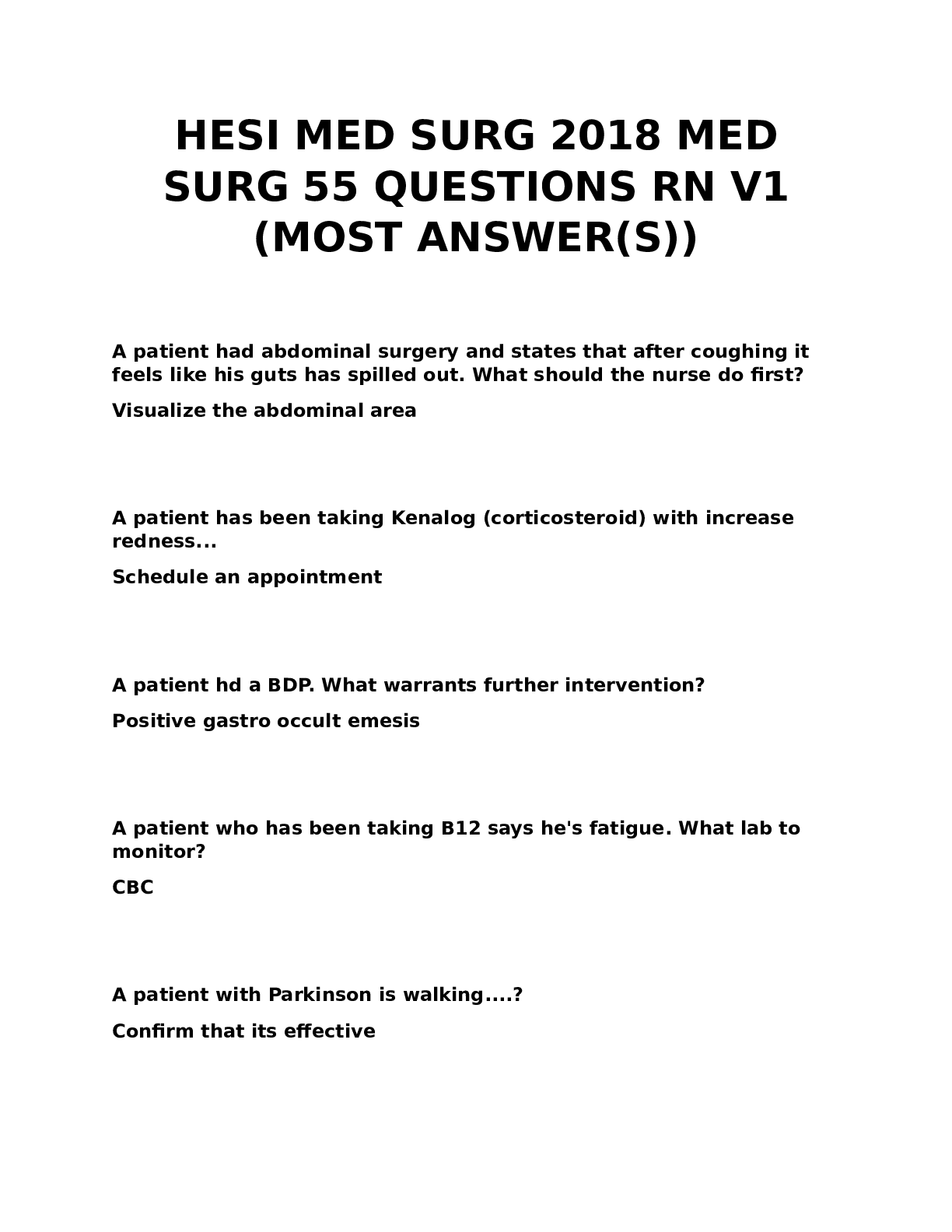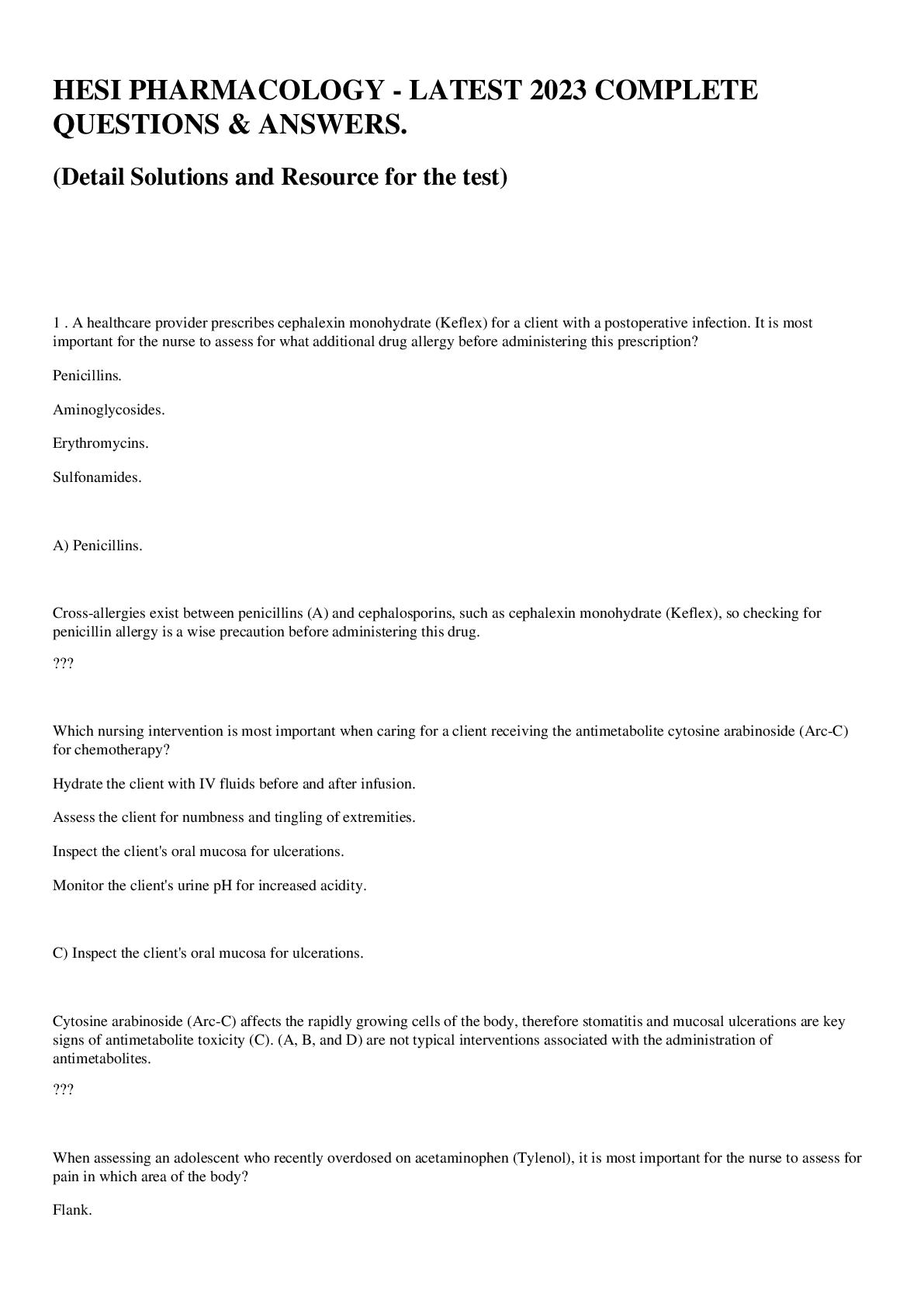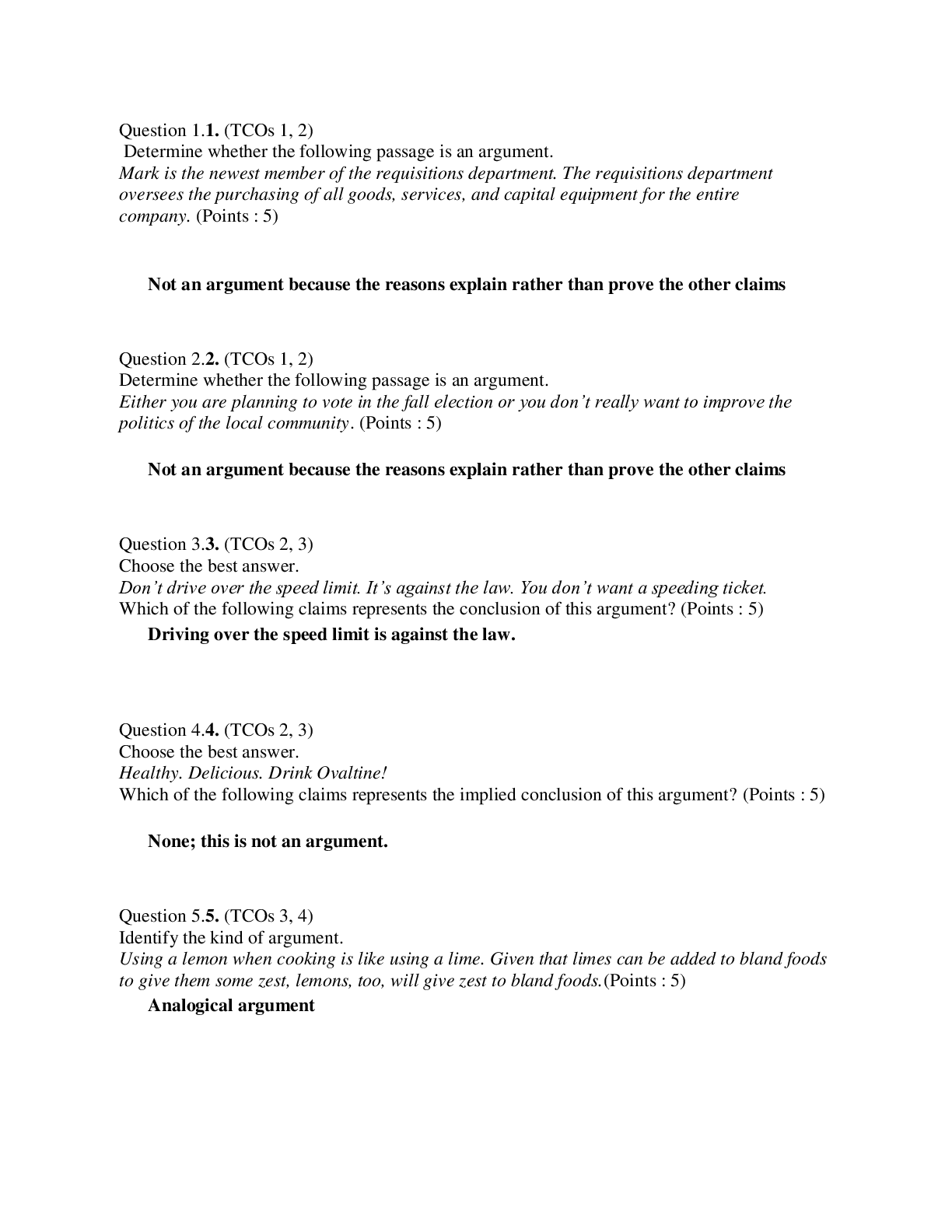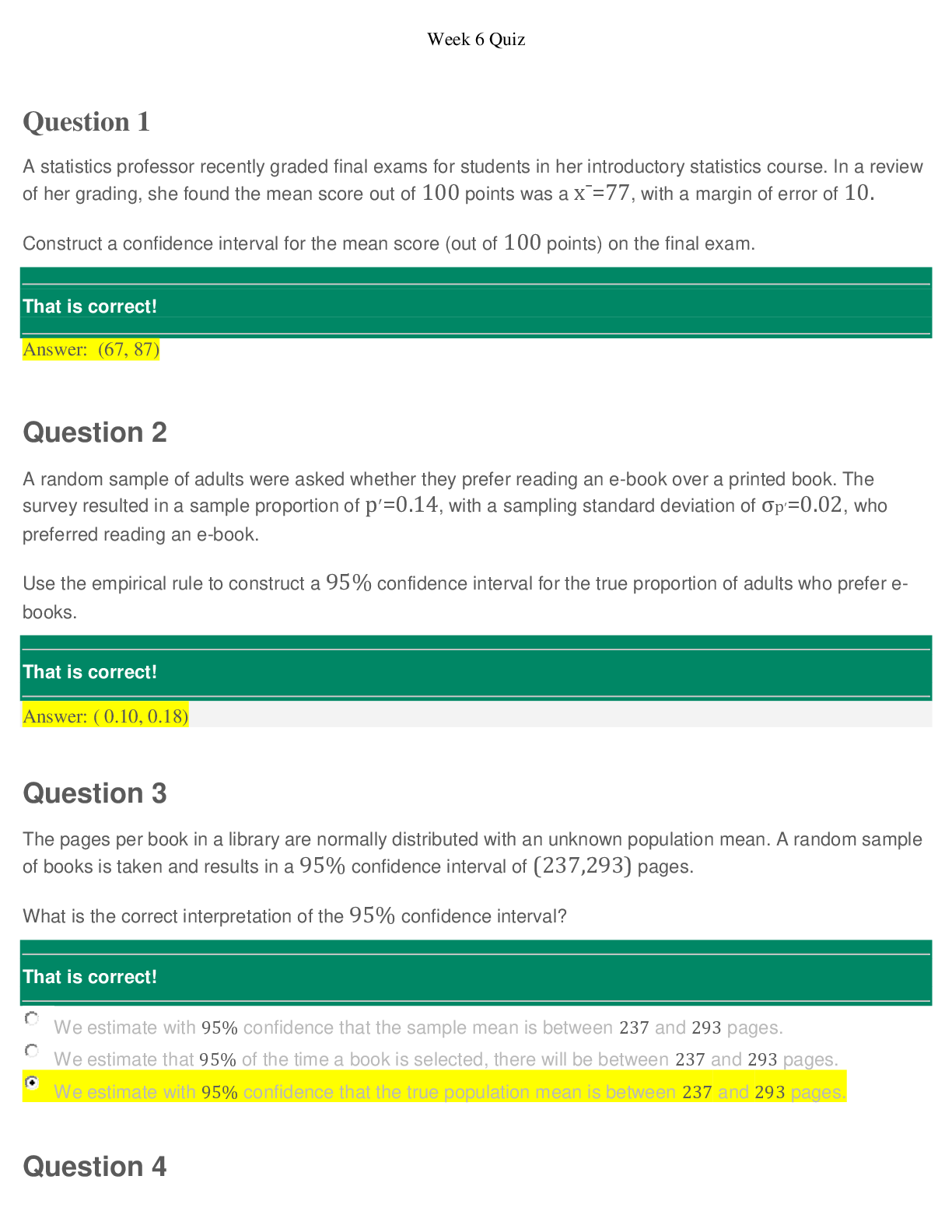*NURSING > EXAM > Psychiatric Mental Health Nursing Test Part 1,2,3,4 COMPLETE MCQ (Answers Explained & Rationale) (La (All)
Psychiatric Mental Health Nursing Test Part 1,2,3,4 COMPLETE MCQ (Answers Explained & Rationale) (Latest): Chamberlain College Of Nursing(Verified answers, download to score A)
Document Content and Description Below
Psychiatric Mental Health Nursing Test Part 1 (Set-1) MCQ (Answers Explained & Rationale) (Latest): Chamberlain College Of Nursing NURSING 326 Psychiatric Mental Health Nursing Test Bank Part 1 (Set-1... ): MCQ (Answers Explained & Rationale) (Latest): Chamberlain College Of Nursing NURSING 326 Psychiatric Mental Health Nursing Test Bank Part 1 (Set-1): MCQ (Answers Explained & Rationale) (Latest): Chamberlain College Of Nursing 1. Your patient is very dependent and submissive. There are times that the patient is very clingy. This behavior reflects what type of personality disorder? a. Antisocial personality b. Dependent Personality c. Manic behavior d. Anxiety disorder 2. The appropriate therapeutic distance between you and a psychiatric patient is? a. 12 inches b. 35 inches c. 12 feet d. 4 feet 3. Nurse Anna is instructing the new nurse to the psychiatric set-up. She also reminded her to use her therapeutic communication skills in dealing with clients. Which of the following techniques enlaces therapeutic communication? a. What are you thinking about? b. What made you think that way? c. Why did you say that? d. Let’s not talk about that. What do you think? 4. Mr. Juan is diagnosed with Alzheimer’s disease. The nurse’s intervention should focus on helping the client be oriented with the physical set-up and daily events. Which of the following is the most effective nursing intervention in orienting patients who has Alzheimer’s disease? a. Encourage the client to talk to family members to reminisce things b. Provide simple and easily understood directions c. Perform tasks with a variety of activities each day d. Have the client socialize with other patients 5. A therapy that focuses on the remotivation of clients by directing their attention outside themselves to relieve preoccupation with personal thoughts, feelings, and attitudes is known as: a. Pharmacologic therapy b. Music therapy c. Occupational therapy d. Recreational therapy 6. The 12-year old male patient looks like the nurse’s younger brother who is missing for years. During assessment and in the implementation of nursing care the nurse prioritizes this client. One day, when she found the boy crying in his room she hugged him and cried with him. This is an example of: a. Counter-transference b. Transference c. Resistance d. Denial 7. A schizophrenic client is under your care. In reinforcing the functional behavior of this client what will the nurse do? a. Enumerate the symptoms of schizophrenia to the client b. Correct delusional thoughts to orient to reality c. Compliment the client for cessation of acting out behaviors d. Encourage the client to drink his medications religiously 8. A client was brought to the ER. Based on the significant others, the client had a history of shop stealing. However, no self-mutilating activities are committed by the client. During the interview, the client is very manipulative and aggressive and impulsive. What personality disorder most likely the client has? a. Antisocial b. Histrionic c. Narcissistic d. Borderline 9. When the client told the nurse that he feels good when he mutilates or cuts himself the novice psychiatric nurse answered, “Do you know the risks involved when you cut yourself?” what type of nontherapeutic communication is the nurse using? a. Defending b. Testing c. Making stereotyped comments d. Disagreeing 10. A therapy that assists with discharge planning and rehabilitation, focusing on vocational skills and activities of daily living (ADL) to raise self-esteem and promote independence is called: a. Behavior modification b. Milieu therapy c. Recreational therapy d. Occupational therapy 11. Nurse Marie is caring for a patient that underwent alcohol detoxification. Which of the following symptoms would Nurse Marie be most concern? a. Fever b. Delusions c. Excessive sweating d. Increase BP 12. The Distance that is observed when family members or friends are talking is under what zone: a. Intimate b. Therapeutic c. Personal d. Social 13. The client is sharing Nurse Marie about his experiences. Suddenly, he paused, looked to the nurse and is hesitant to continue. The nurse responded, “Go on, and tell me about it.” What therapeutic communication technique is the nurse using? a. Exploring b. Focusing c. Encouraging expression d. General leads 14. In a therapeutic communication, “why questions” are discouraged. For what reason is this question not useful? a. The question is intimidating and the client may be defensive in trying to explain him/herself. b. It forces the client to recognize his or her problems. The client’s acknowledgement that s/he doesn’t know things may be helpful to the nurse’s needs but not the client. c. It indicates that the client is right rather than wrong. d. It tends to make the client used and invaded. 15. An 18 year old client is brought to the ER due to a suicidal attempt. Her mother told the nurse that she has been drinking alcohol for the last 3 weeks and is depressed. In caring for this patient what is the most important consideration? a. Administering antidepressant medications b. Alcohol detoxification c. Allowing the client to participate in a therapy d. Close monitoring 16. In using a therapeutic communication technique interpreting client cues and signals is very important. Clear statements of intent such as the client saying that he wants to kill himself is a/an: a. Covert cues b. Abstract messages c. Concrete messages d. Overt cues 17. A client was admitted due to self-mutilation. One day during one of the sessions, the client told the nurse that cutting himself feels great. What would be the nurse’s best response? a. “Do you know the risks involved when you cut yourself?” b. “I don’t want to hear about that!” c. “The behavior of cutting is not acceptable.” d. “Tell me more about that.” 18. A behavior that can indicate the speaker’s thoughts, feelings, needs and values that he or she acts out unconsciously is called: a. Verbal communication b. Communication c. Nonverbal communication d. Congruent message 19. Restraints are only used for a certain reason. Which of the following is an appropriate reason for placing a client in restraints? a. Punishment for stealing the other client’s things b. Self- harming behaviors c. Verbal abuse d. Not drinking medications 20. If a client is on restraints which of the following would the nurse do? a. Leave the client in the room for the whole 8 hours b. Do not allow the client to eat c. Take pictures of the client for evaluation d. monitor the extremity circulation 21. A client is scheduled for an electroconvulsive therapy (ECT). Which of the following medications can be given to the client before the procedure? a. Atropine b. Epinephrine c. Hydralazine d. Phenobarbital 22. To ensure that your client knows about the procedure, risks and outcome and has been informed of the other alternative therapy. Which of the following must be accomplished? a. A signed informed consent by a client’s family member b. A signed informed consent by a 23-year old client who has voluntarily admitted himself in the unit. c. A signed informed consent of a 23-year old client’s parent d. A signed informed consent by a 17-year old client 23. The client says that he is hearing voices. What is nurse’s initial response? a. “I don’t hear any voices.” b. “From where are those voices coming from?” c. “What are the voices telling you?” d. “Are you sure about that?” 24. What is the most important criteria that must be accomplished by the nurse before dealing with psychiatric patients? a. Salary rate b. Self-awareness c. Self-understanding d. Standard of nursing practice 25. If a client is a chain smoker, how should his medication dosage be adjusted? a. Same medication dose b. Increase the dose c. Decrease the dose d. Withhold the dose [Show More]
Last updated: 2 years ago
Preview 1 out of 64 pages

Buy this document to get the full access instantly
Instant Download Access after purchase
Buy NowInstant download
We Accept:

Reviews( 0 )
$24.50
Can't find what you want? Try our AI powered Search
Document information
Connected school, study & course
About the document
Uploaded On
Mar 04, 2021
Number of pages
64
Written in
Additional information
This document has been written for:
Uploaded
Mar 04, 2021
Downloads
0
Views
122

.png)
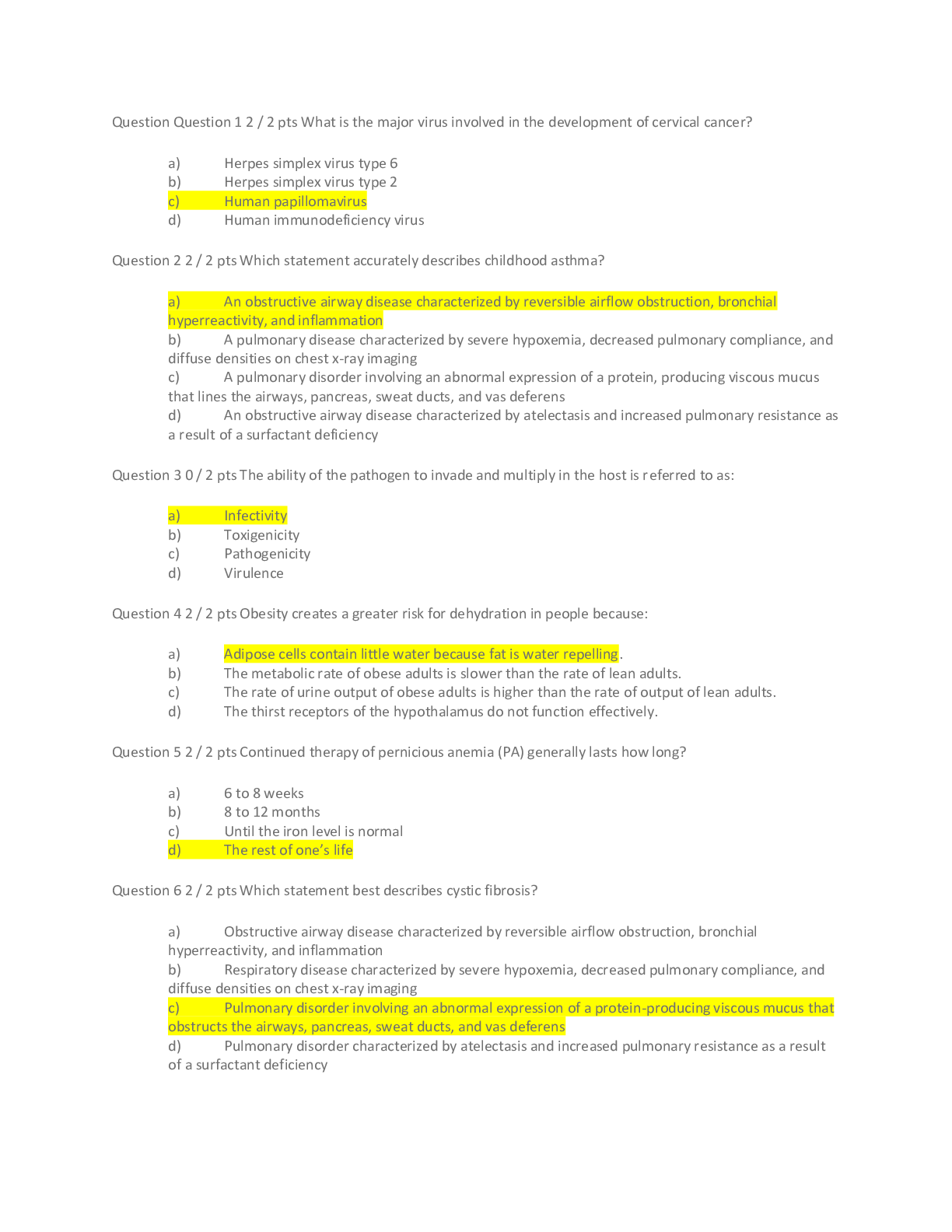
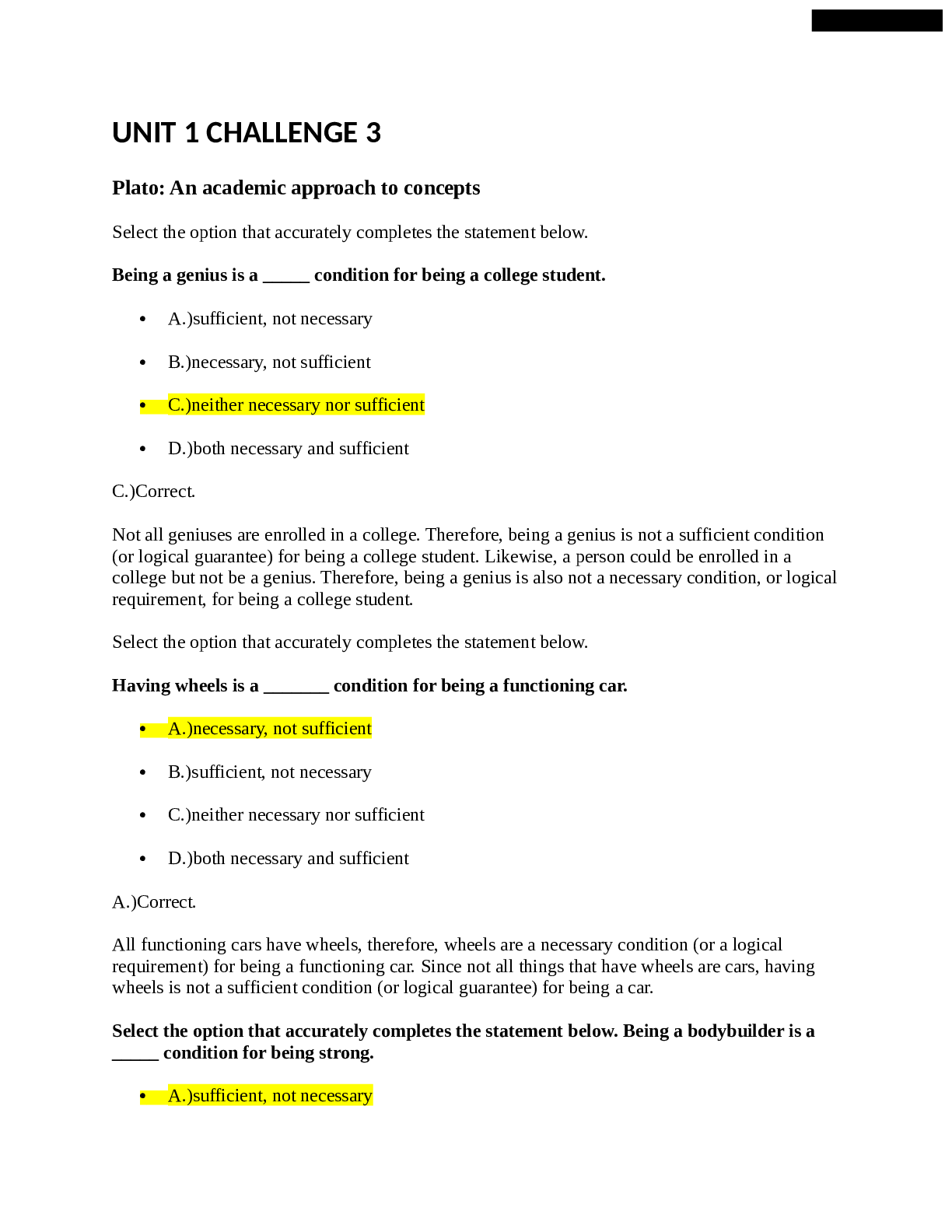
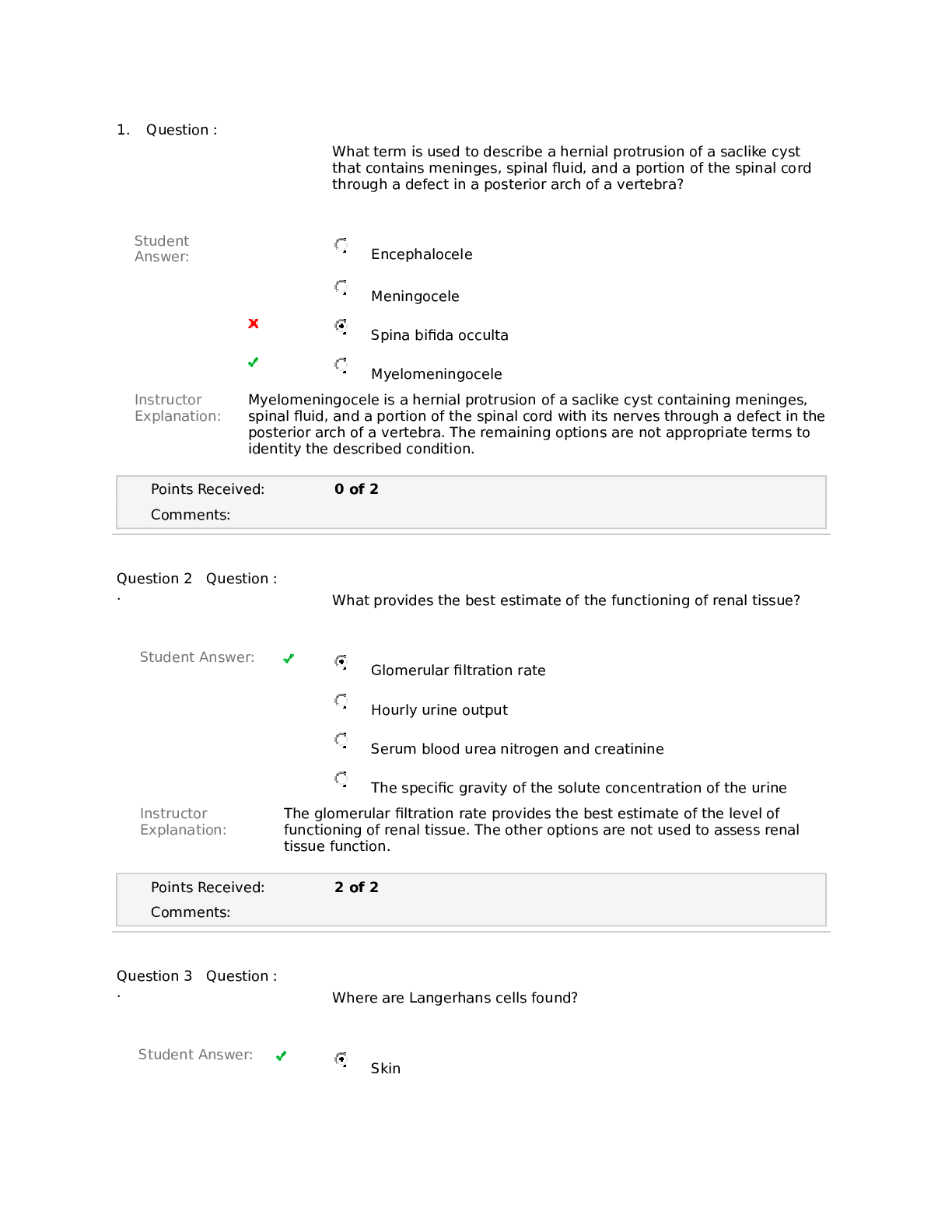
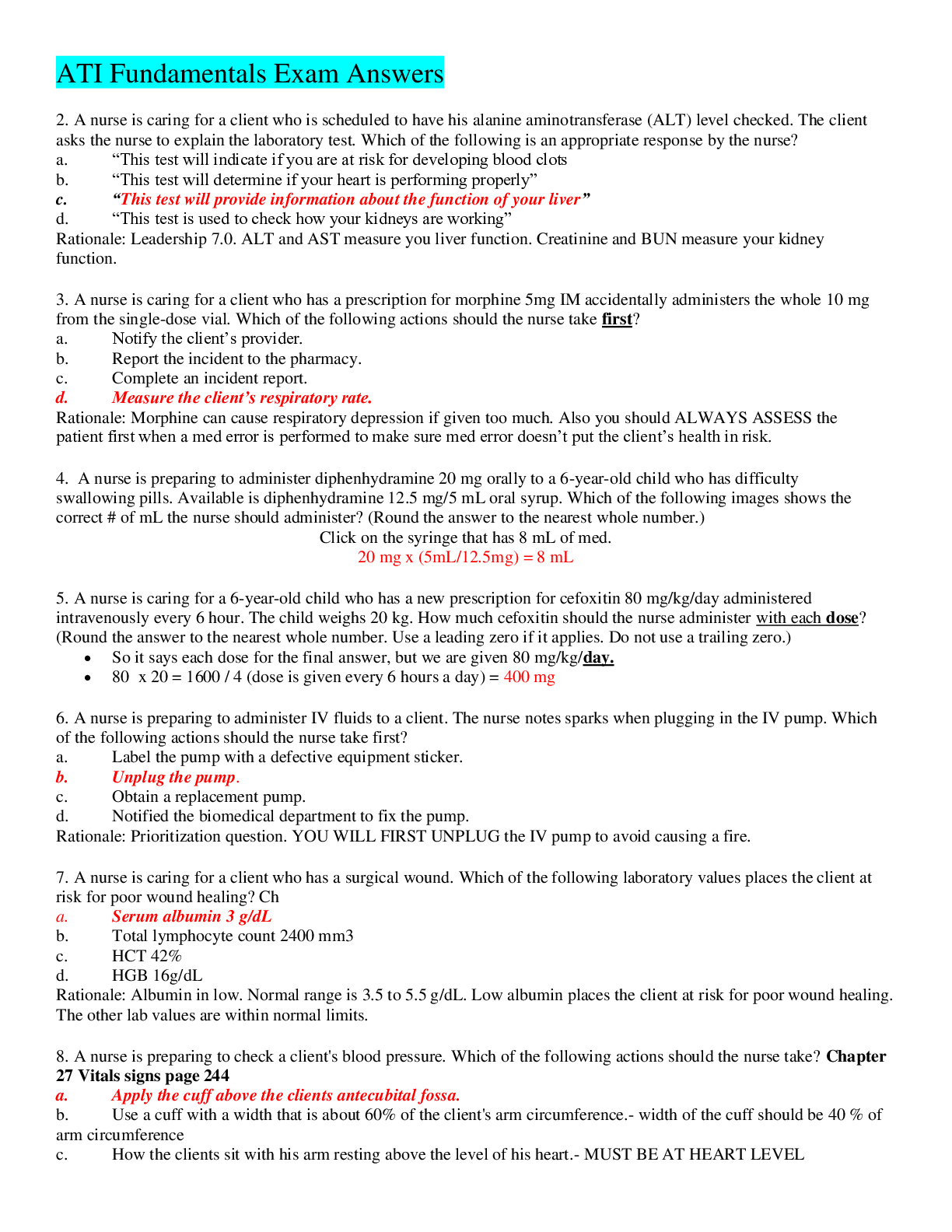
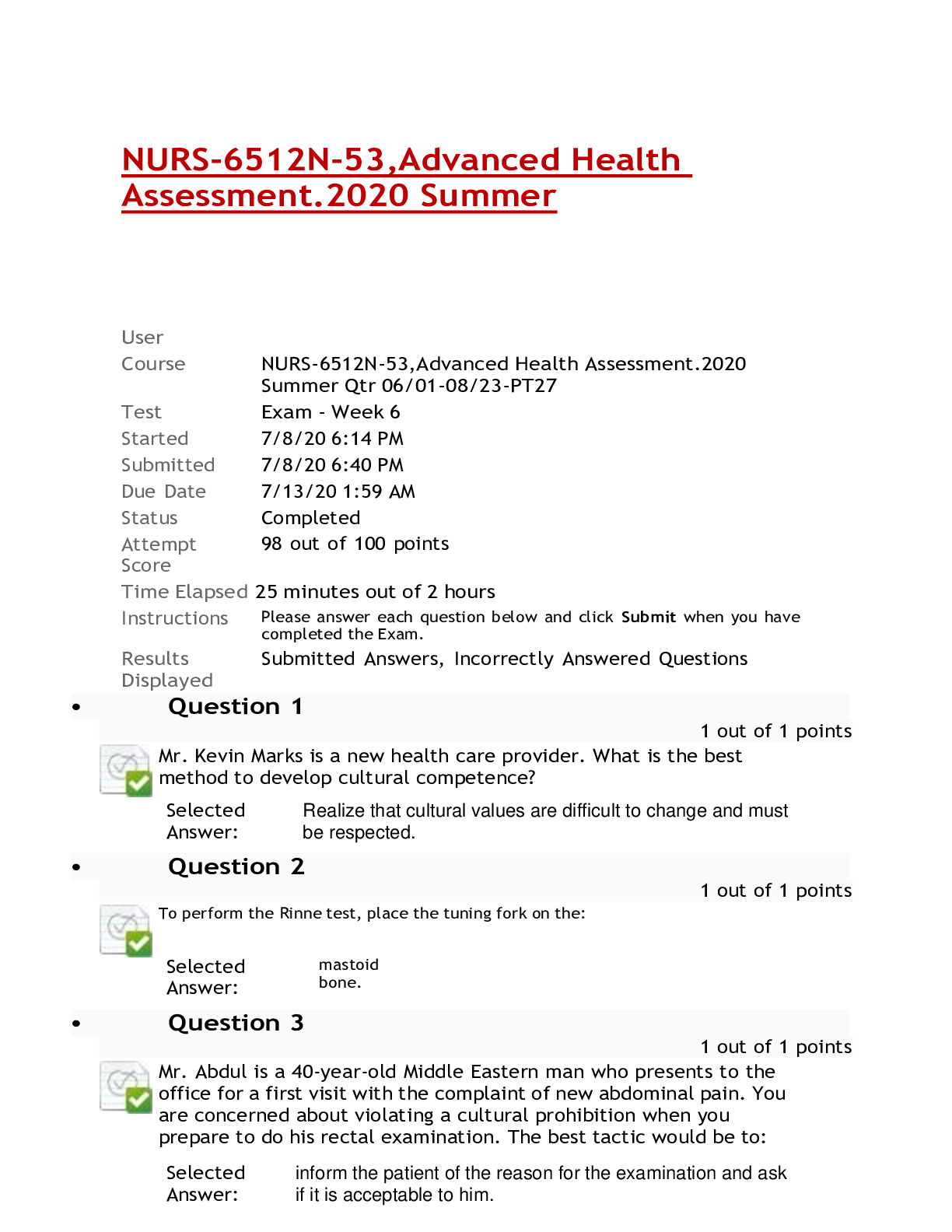
.png)
